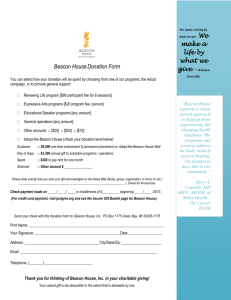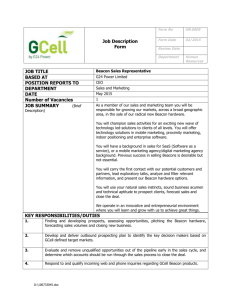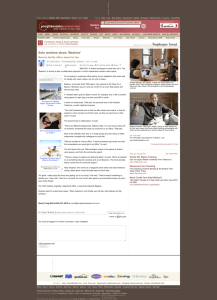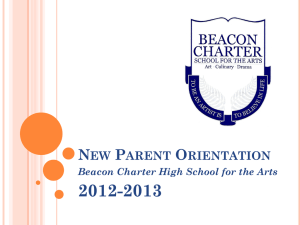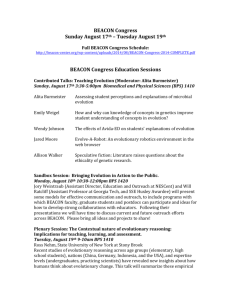2010 BEACON HOUSE Organizational Strategic Plan
advertisement
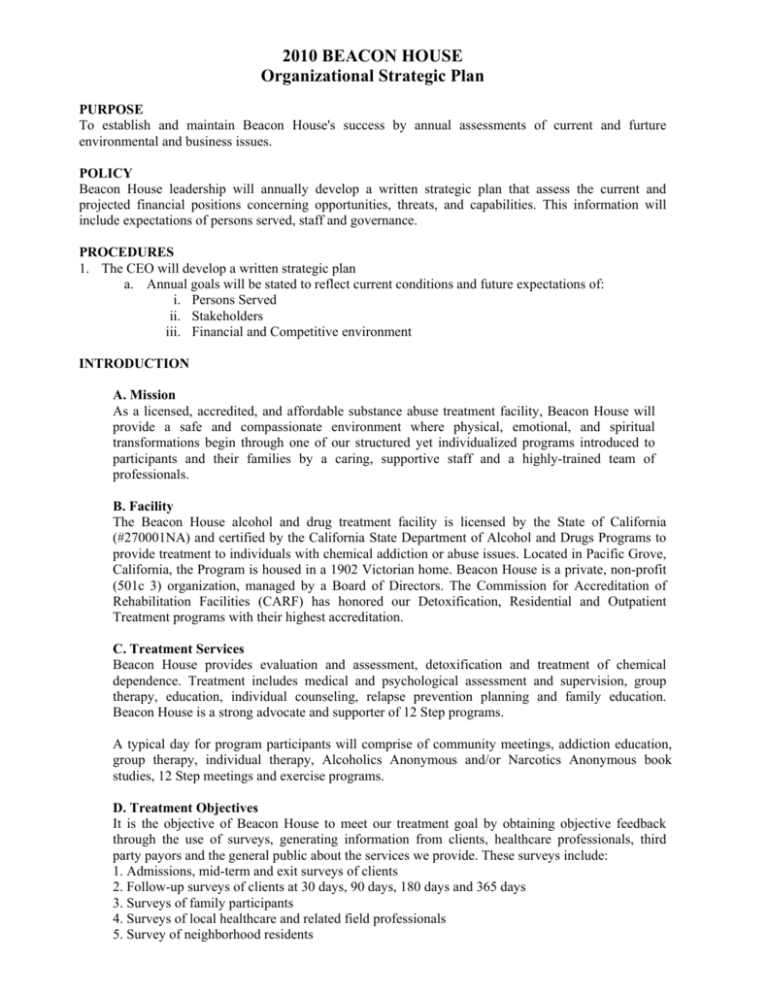
2010 BEACON HOUSE Organizational Strategic Plan PURPOSE To establish and maintain Beacon House's success by annual assessments of current and furture environmental and business issues. POLICY Beacon House leadership will annually develop a written strategic plan that assess the current and projected financial positions concerning opportunities, threats, and capabilities. This information will include expectations of persons served, staff and governance. PROCEDURES 1. The CEO will develop a written strategic plan a. Annual goals will be stated to reflect current conditions and future expectations of: i. Persons Served ii. Stakeholders iii. Financial and Competitive environment INTRODUCTION A. Mission As a licensed, accredited, and affordable substance abuse treatment facility, Beacon House will provide a safe and compassionate environment where physical, emotional, and spiritual transformations begin through one of our structured yet individualized programs introduced to participants and their families by a caring, supportive staff and a highly-trained team of professionals. B. Facility The Beacon House alcohol and drug treatment facility is licensed by the State of California (#270001NA) and certified by the California State Department of Alcohol and Drugs Programs to provide treatment to individuals with chemical addiction or abuse issues. Located in Pacific Grove, California, the Program is housed in a 1902 Victorian home. Beacon House is a private, non-profit (501c 3) organization, managed by a Board of Directors. The Commission for Accreditation of Rehabilitation Facilities (CARF) has honored our Detoxification, Residential and Outpatient Treatment programs with their highest accreditation. C. Treatment Services Beacon House provides evaluation and assessment, detoxification and treatment of chemical dependence. Treatment includes medical and psychological assessment and supervision, group therapy, education, individual counseling, relapse prevention planning and family education. Beacon House is a strong advocate and supporter of 12 Step programs. A typical day for program participants will comprise of community meetings, addiction education, group therapy, individual therapy, Alcoholics Anonymous and/or Narcotics Anonymous book studies, 12 Step meetings and exercise programs. D. Treatment Objectives It is the objective of Beacon House to meet our treatment goal by obtaining objective feedback through the use of surveys, generating information from clients, healthcare professionals, third party payors and the general public about the services we provide. These surveys include: 1. Admissions, mid-term and exit surveys of clients 2. Follow-up surveys of clients at 30 days, 90 days, 180 days and 365 days 3. Surveys of family participants 4. Surveys of local healthcare and related field professionals 5. Survey of neighborhood residents E. Staff The Clinical Staff consist of a clinically licensed psychotherapist, pre-licensed MFT Interns and Trainees, CADAC certified counselors and nurses. Additionally, Beacon House’s Medical Director Dr. John Bennetts has been practicing in the field of chemical dependency treatment since 1985 and is a certified Addictionologist and is ASAM trained and certified. Dr. Lee Larimer, our consulting psychologist, has advanced credentials in clinical psychopharmacology as well as the treatment of alcohol and substance abuse disorders. Most staff members are recovering persons, each with a minimum of 12 continuous months of sobriety. II. PERSONS SERVED A. Target clientele Beacon House provides detoxification, residential, day and partial day treatment, as well as limited ‘extended recovery’ arrangements, to adults, 18 and over, who are experiencing alcohol and drug problems. Beacon House also provides a counseling service on a sliding fee schedule. It is our commitment to ensure that treatment provided is of the highest quality, conducted in an environment that is safe and nurturing, and conducive for the discovery of a new healthy lifestyle. B. Admission Criteria No one is denied treatment on the basis of race, creed, color, religion, ancestry, physical handicap, medical condition, marital status, gender, sexual orientation, national origin or, age in compliance with our license. Treatment is provided at a reasonable cost. Participants must be 18 years or older. III. COMMUNITY NEEDS Assessment of community needs Assessments of the continued need for services such as Beacon House provides are conducted via internal and external surveys measuring… 1. The number and type of requests from calls to Beacon House for various treatment modalities. 2. The response from local professionals (Clinicians, Physicians, Etc.) to surveys inquiring about the frequency of referrals made to the various treatment programs at Beacon House. 3. The desired services by referring insurance companies and HMO’s. 4. Measurement of the various services provided annually. Offering its vast array of services, Beacon House is the only facility of its kind on the Monterey Peninsula. Yet, annually we look to find how we can better serve the general population within the community and those members of the recovering community already using Beacon House as a resource. Thus, Beacon House constantly explores ways to provide new services that meet the current needs of our community. In late 2008 Beacon House recognized the community’s need for a schedule-assessable, cost effective evening outpatient program. Thus, our EIOP program was developed and opened in the first quarter of 2009. Additionally, with an eye towards the future and understanding the industry’s move towards cost-effective long-term treatment, Beacon House developed the Sobriety Life Management program. The only other non-county funded treatment facility on the Peninsula is The Community Hospital of the Monterey Peninsula’s Recovery Center, providing intensive and partial outpatient treatment services only. TRENDS 1. Trends in the industry have changed little since my last annual report. Primary concern always remains the insurance industry’s attitudes towards payment for and managed care of their insured. 2. Again, throughout 2009 we have found insurance companies shortening the length of authorized Residential treatments then systematically reducing the treatment intensity from Full-Outpatient to Partial – Outpatient. While this not a good service to the participant, in 2009 Beacon House developed alternative programs to deal with this trend. a. Evening Outpatient Treatment b. Sober Life Management program IV. PROGRAMS DETOXIFICATION TREATMENT Beacon House is licensed by the State of California and certified to provide ‘non-hospitalized’ detoxification treatment to chemically dependent patients. RESIDENTIAL TREATMENT The Residential Treatment program at the Beacon House has evolved in the fifty plus years of its existence. Beginning as a “sober house” in 1957, Beacon House today is the premier treatment program on the central coast. Providing an array of educational classes and process groups facilitated by master level MFT and LCSW therapist and CACAD certified counselors. The staff at Beacon House has more than seventy years of experience working with the chemically dependent patient. DAY TREATMENT The Day program (PHP) offers treatment in half-day and full-day modalities. Both programs provide an individual an opportunity to receive treatment for chemical dependency while living in their primary residency. The day treatment program is offered as a “stand-alone” track or as a “step-down” track to our Residential Treatment program. Our Half-Day program (IOP) consists of 28 4-hour days of treatment. Each individual receives individual and group counseling and education. It too may be a “step-down” track from either the Residential Program or the Full-day program. EVENING OUTPATIENT TREATMENT Designed for individuals who do not require a more structured program, the Evening Outpatient Program (EIOP) allows participants to continue working and remain at home during their treatment. TRANSITIONAL-LIVING RECOVERY The Transitional-living Recovery program is designed for individuals whom have graduated from either the Beacon House Residential program or from another treatment facility and is in need of additional supervised treatment. Participants stay at the Beacon House for up-to 90 days and are required to obtain a job, enroll in school or volunteer to do community service. COUNSELING SERVICES This program is available to anyone wanting to participate in individual, couples or family counseling. Fees are paid to Beacon House for the service provided based on the gross household income of participants. The counseling services are provided by MFT, LCSW or CADAC interns or trainees, all who are supervised by a licensed therapist. SOBRIETY LIFE MANAGEMENT (Formerly called Case Management) A six-month to one-year program designed to incorporate the support of many in the recovering person’s life; family & friends, sponsors, physicians and clinicians, employers and the Beacon House staff, working together to improve the likelihood of success during the participant’s most challenging time… early sobriety. V. 2010 GOALS Beacon House always looks forward to the upcoming year with the intent of improving the quality of services already provided and exploring new services that will enhance our treatments and fiscal stability. Steps to maintain mission and fiscal responsibility In order to meet our mission of providing the very best in treatment (and treatment options) and finally, to ensure the fiscal health of Beacon House in 2010 we will focus on improvements of our current treatment modalities. 1. Beacon House will increase exposure via a more aggressive marketing plan to potential local and external users a. Improve the exposure of the Sobriety Life Management program to all recovering individuals in our community, thus; 1. Improving the likelihood of continued sobriety 2. Increasing revenue 2. Beacon House will incorporate the use of modern and mandated database programming 3. Beacon House will increase productivity with improved management and supervision of the clinical office 4. Beacon House will increase fundraising with an established event and board participation. 5. A primary goal for 2010 is a successful accreditation review from CARF VI. QUALITY ASSURANCE It is the intent of Beacon House to monitor the quality of our product, in this case, treatment for chemical dependency. To insure the quality of the Beacon House programs we collect and review data monthly on several facets of the program. You will see the results of these surveys in the Addendum of this report. Quality Assurance / CARF Committee The Quality Assurance Committee meets monthly to review overall program, safety, personnel and other related issues pertaining to the operation of the Beacon House. The committee consists of staff representing the treatment team, food service, administrative and billing, health and safety and marketing. Quality Assurance Reviews The Quality Assurance Committee meets to review whether or not we are accomplishing our mission, goals and objectives in providing the best in treatment to those experiencing dependency to alcohol and/or chemicals. For the purpose of this report the most pertinent are mentioned. Administrative 1. Primary efforts have focused on fiscal management during a difficult year while maintaining the highest quality of services to our community. 2. The reorganization of personnel in the clinical office following the loss of two counselors and, at the end of 2009, the resignation of the treatment coordinator. Clinical 1. New and improved treatment programs to enhance likelihood of successful outcomes a. EIOP b. Sober Life Management program 2. Improvements in survey recording and delivery a. In 2010 new database program is assist in this process 3. In-service Training & Continuing Education Health & Safety 1. Interior and exterior inspections for compliance and safety 2. Drills for fire, earthquakes and terrorist acts 3. In-service Trainings a. Accident Reporting b. Utility Shut-off c. Emergency preparedness d. CPR & First Aid training VII LOSS EXPOSURE A primary exposure issue is the structural condition of the Beacon House itself. Housed in a 1902-built Victorian, Beacon House, naturally experiences roofing, plumbing and electrical concerns continuously. Systematically, we are working through many much-needed restoration projects to ensure the safety of program participants and staff alike and, to resolve these problems while the cost of materials and labor are reasonable (current Vs future cost). A second and equally important exposure issue is the retention of quality staff. Beacon House uses the NAATP salary survey to determine pay and benefit structure for its employees. In late 2008 the board of directors authorized a new 401.3b retirement program for its employees. The amount matched by the agency will be determined annually at the time of budget development. Finally, dealing with the continued economical conditions of the country will be a constant issue in 2010. A primary goal for this and every year is the retention of the highest level of personnel while maintaining the very high quality of services we are committed to providing. VIII HUMAN RESOURCES How Beacon House addresses the replacement of any departing employees will be determined in part by the census of programs and the continuous effort to provide the highest levels of care while practicing effective and efficient business practices. IX 2009 FINDINGS AND IMPROVEMENTS 1. The economic downturn throughout our entire country created for our potential customers, at best, a sense of financial uncertainty… a. For those without insurance, the ability to pay $10,000 or more for treatment while not knowing if they will have a job the following week had to influence the decision to seek treatment or not; b. The economy must of also influenced some not to seek treatment at the Beacon House or any other treatment program even when insurance was available due to not having the means to cover a deductable or co-pay; 2. A second factor, driven again by the economy and the changing health insurance landscape was the propensity of insurance companies to manage the care of their insured more aggressively than in past years. The results of this behavior had and has on Beacon House are as follows; a. Fewer admissions at the onset of treatment into our primary revenue generating program – Residential Thus, few admits into our Detoxification program b. Participants in our Residential program were stepped-down quicker than ever before into a less intense / less revenue generating program A possible second step-down occurring 3. A significant number of those participants stepped down that chose not to remain on campus and pay room & board. c. In 2009 we realized a $61,775 loss of income in this revenue category alone. I attribute this directly to the economy and a participant’s ability or willingness to pay for these services. While each of these factors are real and will probably be with us for most if not all of 2010, we did not sit and wait helplessly hoping the economy would turn around. As early as summer of 2008 the Quality Assurance Committee began looking at potential new programs designed to help those not yet reached by Beacon House and programs that could add to our revenue stream. Three potential programs were identified. a. After making a review of existing programs throughout the Monterey –Salinas area and by evaluating their accessibility and cost, it was determined that Beacon House could do a better job providing a schedule-assessable, cost effective evening outpatient program than anybody else around. Thus, our EIOP program was developed and opened in the first quarter of 2009. We had 39 admits into this program our firstyear with revenues of $144,120. b. To make it easier for individuals to afford the cost of treatment at Beacon House we offered significant cash discounts and offered additional sponsored support to others to offset the cost of deductibles and co-payment. c. We began providing, at no cost, a once-a-week family support program open to family members and supporters of our program participants. As an adjunct to this program, once a month we invited family members to attend a Friday-NightBefore-Family-Intensive group introductory Al Anon meeting. Also free.

